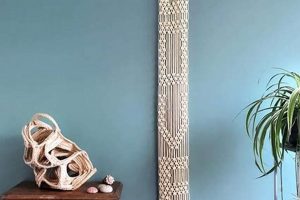A decorative interior design feature created by attaching wooden elements to a wall surface, often to introduce texture, color, or visual interest to a room. For example, individuals might install reclaimed lumber horizontally across a living room wall to create a rustic aesthetic, or apply precisely cut geometric shapes for a modern design.
These installations can significantly enhance a room’s character, increase property value, and offer a cost-effective alternative to extensive renovations. Historically, wood paneling served functional purposes such as insulation; its modern iterations prioritize aesthetic appeal and personalization, reflecting evolving trends in home decor and design.
The following sections will detail the materials, tools, and techniques required for successful implementation, emphasizing safety considerations and design principles for optimal results.
Tips for Installing a Wooden Feature
Successful execution requires careful planning and adherence to established best practices. The following tips provide guidance for achieving a professional-looking outcome and ensuring the longevity of the installation.
Tip 1: Accurate Measurement and Planning: Precise measurements are critical. Develop a detailed plan that accounts for wall dimensions, stud locations, and desired pattern. This reduces material waste and minimizes errors during installation.
Tip 2: Material Selection: Choose wood suitable for interior applications. Consider factors such as wood species, grain pattern, and moisture content. Kiln-dried lumber is recommended to prevent warping or cracking after installation.
Tip 3: Surface Preparation: Ensure the wall surface is clean, dry, and level. Repair any imperfections before beginning the installation. Priming the wall can improve adhesion and prevent staining from the wood.
Tip 4: Secure Attachment: Use appropriate fasteners (nails, screws, or adhesive) to securely attach the wood to the wall studs or drywall. Improper fastening can lead to loosening or detachment over time. Consider using a stud finder to locate studs accurately.
Tip 5: Precise Cutting: Accurate cuts are essential for a professional finish. Use a miter saw or circular saw with a sharp blade to achieve clean, straight edges. A jig or guide can improve cutting accuracy.
Tip 6: Consistent Spacing: Maintain consistent spacing between wood pieces using spacers or shims. This creates a uniform appearance and allows for expansion and contraction due to temperature and humidity changes.
Tip 7: Proper Finishing: Apply a suitable finish (stain, paint, or sealant) to protect the wood and enhance its appearance. Follow the manufacturer’s instructions for application and drying times.
Adhering to these guidelines ensures a structurally sound and aesthetically pleasing outcome, enhancing the overall design and value of the space.
The subsequent sections will explore specific design styles and advanced techniques for further customization.
1. Material Selection
Material selection is a foundational aspect in the creation of any wooden feature, directly influencing its aesthetic appeal, structural integrity, and overall longevity. The choice of material dictates the project’s ease of execution, cost-effectiveness, and suitability for the intended environment.
- Wood Species and Aesthetics
Different wood species exhibit distinct grain patterns, colors, and textures that significantly impact the final aesthetic. For example, cedar offers a warm, reddish hue and natural resistance to decay, making it suitable for humid environments, while pine presents a lighter color and is often more affordable but requires sealing for protection. The chosen wood should complement the existing interior design and desired visual impact.
- Durability and Longevity
The durability of the selected wood directly affects the lifespan of the installation. Hardwoods like oak or maple are more resistant to scratches and dents, making them ideal for high-traffic areas. Softwoods, while easier to work with, may require more frequent maintenance and repairs. The expected lifespan and usage patterns of the space should guide the choice of wood.
- Cost Considerations
Material costs can vary significantly depending on the wood species, grade, and availability. Reclaimed wood, while visually appealing and environmentally friendly, often requires more preparation and can be more expensive than commercially sourced lumber. MDF (Medium-Density Fiberboard) provides a cost-effective alternative but lacks the natural grain and character of solid wood. Budget constraints should be carefully balanced with desired aesthetic and performance characteristics.
- Workability and Installation
The ease with which a wood can be cut, shaped, and fastened impacts the complexity and efficiency of the installation process. Softwoods are generally easier to cut and nail, making them suitable for beginners, while hardwoods may require specialized tools and techniques. The installer’s skill level and available equipment should inform the choice of material.
The interplay of these factors demonstrates that thoughtful material selection is not merely a matter of aesthetic preference but a critical determinant of the success and long-term performance of any decorative wood application. The selected material must align with the project’s design goals, budgetary limitations, and the intended use of the space, ensuring a visually appealing and structurally sound outcome.
2. Design Planning
The integration of design planning and the execution of a wooden feature is inextricably linked, functioning as a critical determinant of project success and visual impact. Lack of thorough design foresight can lead to misalignment between the intended aesthetic and the final result, resulting in wasted materials, increased labor costs, and compromised structural integrity. A well-conceived design plan, conversely, acts as a roadmap, guiding material selection, installation techniques, and overall project management.
Specific examples underscore the importance of this connection. Consider a project involving a herringbone pattern on a wall. Without precise measurements and a detailed layout plan, the pattern may be skewed, creating an uneven and unprofessional appearance. In contrast, a project with detailed schematics ensures accurate cuts and seamless alignment, resulting in a visually stunning and structurally sound installation. Another instance involves the use of reclaimed lumber, which often exhibits variations in thickness and width. A design plan that accommodates these irregularities minimizes material waste and ensures a cohesive overall design. Furthermore, proper planning includes assessing the wall’s structural capacity to support the added weight, preventing potential structural damage. This assessment informs the choice of materials and attachment methods, ensuring safety and longevity.
In summary, design planning is not merely a preliminary step but an essential component that dictates the outcome of any decorative wood application. Addressing challenges such as uneven walls, material variations, and weight considerations through comprehensive design planning mitigates risks and maximizes the potential for achieving a successful and aesthetically pleasing installation. This understanding aligns with broader themes of resource efficiency, structural integrity, and aesthetic harmony within interior design.
3. Wall Preparation
Wall preparation is a foundational step directly influencing the success and longevity of any wooden feature installation. The condition of the substrate beneath directly affects the adhesion, alignment, and overall visual outcome. Inadequate surface preparation inevitably leads to compromised results, necessitating costly repairs or complete reinstallation. For instance, applying wood directly to a dusty or uneven wall will result in poor adhesion, causing the wooden elements to loosen or detach over time. A level surface is essential for ensuring the wood lies flush, preventing unsightly gaps or warping. Further, failing to prime a wall before applying wood can lead to moisture absorption and potential mold growth behind the wooden feature. Such scenarios highlight the detrimental effects of neglecting proper preparatory procedures.
Proper wall preparation involves several critical steps. First, the wall must be thoroughly cleaned to remove dust, dirt, and any existing coatings. Next, imperfections such as holes or cracks should be filled and sanded to create a smooth, even surface. A primer should then be applied to seal the wall and improve adhesion. In cases where the wall is significantly uneven, furring strips may be necessary to create a level plane for attachment. These strips are typically attached to the studs behind the wall, providing a solid, even base for the wood. Consider a situation where a homeowner installs shiplap directly onto an unprimed wall in a bathroom; moisture seeping from the unsealed drywall would lead to warping and potential mold growth, rendering the installation structurally unsound. Conversely, properly preparing the wallcleaning, patching, and primingensures a stable, moisture-resistant surface for the shiplap.
In summary, thorough wall preparation is not merely a preliminary task but a critical component that dictates the structural integrity and aesthetic appeal. Neglecting this step invariably leads to compromised results and potential long-term issues. Adherence to established best practices ensures a durable, visually pleasing outcome, ultimately maximizing the value and longevity of the design feature. The significance of wall preparation underscores its integral role within the broader context of interior design and construction.
4. Accurate Cutting
Precise dimensional accuracy is paramount in the construction of any “diy wood accent wall.” Deviations from specified measurements directly impact the overall aesthetic, structural integrity, and ease of installation. Accurate cutting ensures that individual components fit seamlessly together, creating a visually cohesive and structurally sound finished product.
- Mitigation of Material Waste
Accurate cutting minimizes the potential for material waste, which is a significant consideration for both budgetary and environmental reasons. By adhering closely to predetermined dimensions, material usage is optimized, reducing the need for additional purchases and minimizing disposal of unusable scraps. For instance, when installing a herringbone pattern, precise cuts are critical to avoid small, unusable pieces that would otherwise be discarded. The economic and ecological benefits of efficient material utilization are substantial.
- Enhancement of Visual Cohesion
The visual impact of a wood application is directly related to the precision of the cuts. Clean, straight edges and consistent dimensions contribute to a polished, professional appearance. Inconsistent cuts result in gaps, misalignments, and an overall disjointed aesthetic. For example, when creating a geometric design, each piece must be cut with exacting precision to maintain the intended pattern and symmetry. The visual appeal of the final product hinges on this level of accuracy.
- Facilitation of Easier Installation
Accurate cuts significantly simplify the installation process. When components are cut to the precise dimensions, they fit together with minimal effort, reducing the need for adjustments or modifications during installation. This streamlined process saves time and minimizes potential errors. For instance, with shiplap, uniform dimensions ensure a consistent reveal between each board, resulting in a smooth, professional-looking installation. Accurate cutting translates directly into efficient and trouble-free installation.
- Improvement of Structural Stability
The structural integrity is influenced by the precision of the cuts, especially in installations involving interlocking or load-bearing elements. Accurate cuts ensure that each component properly supports the adjacent pieces, contributing to the overall stability of the structure. In applications using interlocking joints, for example, precise cuts are critical to create a secure and robust connection. The long-term durability relies on this initial precision.
These facets highlight the critical importance of accurate cutting. The success of a project is not solely dependent on the quality of the materials used but also on the precision with which they are prepared. From reducing waste and improving aesthetics to simplifying installation and enhancing stability, accurate cutting is an indispensable aspect of any successful venture.
5. Secure Attachment
The longevity and safety of any wooden feature are directly contingent upon the integrity of its attachment to the underlying wall structure. Insufficient or improper fastening methods invariably lead to instability, potential detachment, and compromised aesthetics. The relationship is causal: insecure attachment precipitates structural failure. Consequently, selection of appropriate fasteners and application techniques is not a mere procedural step but a critical determinant of long-term performance. For example, using solely adhesive on heavier wood panels without mechanical fasteners often results in eventual detachment due to gravity and environmental factors. Similarly, using drywall screws directly into drywall without engaging a stud provides inadequate holding power, especially with thicker wood. Therefore, the method of secure attachment is inextricably linked to the overall success of the installation.
Practical application of secure attachment principles involves several considerations. Identifying wall stud locations is paramount for providing secure anchor points for fasteners. Appropriate fastener selection includes screws, nails, or construction adhesive, each possessing specific load-bearing capabilities. Pre-drilling pilot holes minimizes the risk of splitting wood, ensuring a more robust connection. The spacing of fasteners should be determined based on the weight and dimensions of the wood, with closer spacing required for heavier or larger pieces. Further, the type of wall construction (drywall, plaster, concrete) dictates the optimal fastener type and installation method. For instance, concrete walls require specialized anchors and drilling techniques to ensure secure attachment. An understanding of these practical aspects is essential for achieving a stable and durable installation. Adhesive may be use but adhesive on its own may not be sufficient
In summation, secure attachment is not simply a task but a critical system that dictates the structural integrity. Neglecting this aspect invariably leads to compromised results. Adherence to best practices ensures a durable, visually pleasing feature, ultimately maximizing its value and longevity. The challenge lies in understanding the specific requirements of each project, selecting appropriate materials and techniques, and executing the installation with precision. The understanding reinforces fundamental principles of construction and design.
6. Level Installation
Maintaining horizontal and vertical alignment during the installation of any wooden wall feature is crucial for achieving a visually appealing and structurally sound result. Deviation from a true plane can introduce distortions, detract from the intended aesthetic, and potentially compromise the long-term stability of the structure. Level installation is therefore not merely a cosmetic consideration but an integral aspect of quality craftsmanship.
- Aesthetic Harmony
Precise leveling ensures that the wooden elements align correctly, creating a sense of order and visual harmony. Uneven installation can result in sloping lines, asymmetrical patterns, and an overall disjointed appearance, detracting from the aesthetic intent. For example, consider a horizontal shiplap application where boards are not installed level. The resulting uneven lines would be immediately noticeable, diminishing the visual impact of the entire feature.
- Structural Integrity
Level installation contributes to the structural integrity of the feature. Unevenly installed elements can create stress points, potentially leading to warping, cracking, or even detachment over time. This is particularly relevant in situations where the wood is supporting any weight or is subject to environmental fluctuations. For instance, a vertical application of heavy wood planks that is not plumb can exert undue stress on the lower attachment points, increasing the risk of failure.
- Ease of Installation
Maintaining level throughout the installation process facilitates accurate alignment and simplifies the attachment process. When elements are consistently level, they fit together seamlessly, reducing the need for adjustments or modifications. This streamlines the installation, saving time and minimizing the potential for errors. Conversely, attempting to install wood on an uneven or non-level plane requires constant adjustments, increasing the complexity and duration of the project.
- Perception of Quality
Precise execution is a hallmark of quality craftsmanship, conveying attention to detail and a commitment to excellence. A level installation creates a perception of professionalism and skill, enhancing the overall value and appeal. Conversely, an uneven installation projects an image of carelessness or inexperience, diminishing the perceived quality of the entire project. This perception influences not only the visual impression but also the long-term satisfaction with the finished result.
These facets underscore the critical importance of level installation. The success of a wooden wall feature relies not only on the quality of the materials but also on the precision with which they are installed. From enhancing aesthetics and ensuring structural integrity to facilitating installation and conveying quality, level installation is an indispensable aspect of any successful project.
7. Protective Finishing
Protective finishing represents a critical and inseparable component of any successful “diy wood accent wall” installation. The application of a suitable finish acts as a protective barrier, mitigating the detrimental effects of environmental factors such as moisture, ultraviolet radiation, and physical abrasion. This barrier, in turn, significantly extends the lifespan of the wooden feature and preserves its aesthetic appeal. The absence of protective finishing directly correlates with accelerated deterioration of the wood, leading to warping, cracking, discoloration, and increased susceptibility to pest infestation. For example, a wooden accent feature installed in a bathroom without a moisture-resistant sealant will likely exhibit water damage and mold growth within a relatively short timeframe. Thus, protective finishing is not merely an aesthetic enhancement but a functional necessity.
The selection of an appropriate finish depends on several factors, including the type of wood used, the intended environment, and the desired aesthetic. Oil-based finishes provide excellent water resistance and durability, making them suitable for high-traffic areas or environments with high humidity. Water-based finishes offer lower VOC emissions and are often preferred for interior applications where air quality is a concern. Polyurethane coatings provide a durable, scratch-resistant surface, while varnishes offer a high-gloss finish. The proper application of a finish involves careful surface preparation, including sanding and cleaning, followed by multiple thin coats applied according to the manufacturer’s instructions. A common error involves applying a single thick coat, which can lead to uneven drying, runs, and reduced protective effectiveness. A practical example is staining a wood feature to match an existing decor, and then applying a polyurethane finish to protect the stain and wood surface.
In summary, the application of protective finishing is an indispensable step in the installation process. This step is crucial to ensuring longevity, aesthetic preservation, and structural integrity. While the initial installation may seem complete without it, the long-term consequences of neglecting this phase are significant and often costly to rectify. Prioritizing proper finishing techniques not only extends the lifespan of the wood but also enhances its overall value, solidifying its position as an intentional and lasting design element. Understanding the interplay between material vulnerability and environmental stressors is key to a successful outcome, ensuring that the feature remains a source of pride and aesthetic enhancement for years to come.
Frequently Asked Questions
The following questions address common concerns and misconceptions regarding the installation of a wooden feature. These answers aim to provide clarity and guidance for a successful project.
Question 1: What is the optimal thickness for wood used in a “diy wood accent wall”?
The appropriate thickness is determined by the type of wood, the desired aesthetic, and the method of attachment. Thicker wood (e.g., 3/4 inch) provides greater rigidity and visual depth but requires more robust fasteners and a stronger supporting structure. Thinner wood (e.g., 1/4 inch) is lighter and easier to work with but may require additional backing for support.
Question 2: How is proper ventilation ensured behind a wooden feature?
Adequate ventilation is achieved by creating a small gap between the back of the wood and the wall surface. This can be accomplished using furring strips or spacers. Ventilation minimizes moisture buildup, preventing mold growth and wood rot. Proper sealing of the room and an appropriate vapor barrier can help to ensure proper ventilation.
Question 3: What are the safety precautions when cutting wood indoors?
When cutting wood indoors, adequate ventilation is crucial to minimize exposure to dust particles and fumes. The use of a dust mask or respirator is recommended. Eye protection, such as safety glasses, is also essential. Power tools should be used in accordance with the manufacturer’s instructions, and a stable work surface should be used to prevent accidents.
Question 4: What is the recommended method for concealing nail or screw holes?
Nail or screw holes can be concealed using wood filler or putty that matches the color of the wood. The filler should be applied smoothly and allowed to dry completely before sanding flush with the surface. Staining or painting can then be applied to blend the filled holes seamlessly with the surrounding wood.
Question 5: How is the correct amount of wood calculated for a specific wall size?
The amount of wood required is determined by calculating the surface area of the wall and accounting for any waste due to cuts or patterns. It is advisable to purchase an additional 10-15% of material to accommodate unforeseen errors or design changes.
Question 6: What is the process for removing a wooden feature without damaging the underlying wall?
Removing a feature requires carefully detaching each piece, minimizing damage to the drywall. Scoring the edges of the wood to sever any adhesive bond. Using a pry bar and applying gentle pressure. Patching and repairing any holes or imperfections in the underlying wall is essential.
These responses underscore the importance of meticulous planning and execution. A clear understanding of these fundamentals contributes significantly to a successful and visually appealing outcome.
The subsequent section will explore advanced techniques for incorporating lighting and other decorative elements.
Conclusion
The preceding exploration has detailed the essential facets of diy wood accent wall construction, emphasizing material selection, design considerations, installation techniques, and long-term maintenance. From ensuring structural integrity through secure attachment to preserving aesthetic appeal with protective finishes, each element contributes to the success of the project. Proper planning and adherence to established best practices are critical determinants of a durable and visually compelling feature.
The information provided serves as a foundational resource for achieving professional-grade results. Further research and careful consideration of individual project requirements are encouraged to maximize the impact and longevity. Implementation of these principles enables the creation of interior design elements that enhance property value and contribute to a more aesthetically pleasing environment. The ability to transform interior spaces will further enhance a house into a home.







